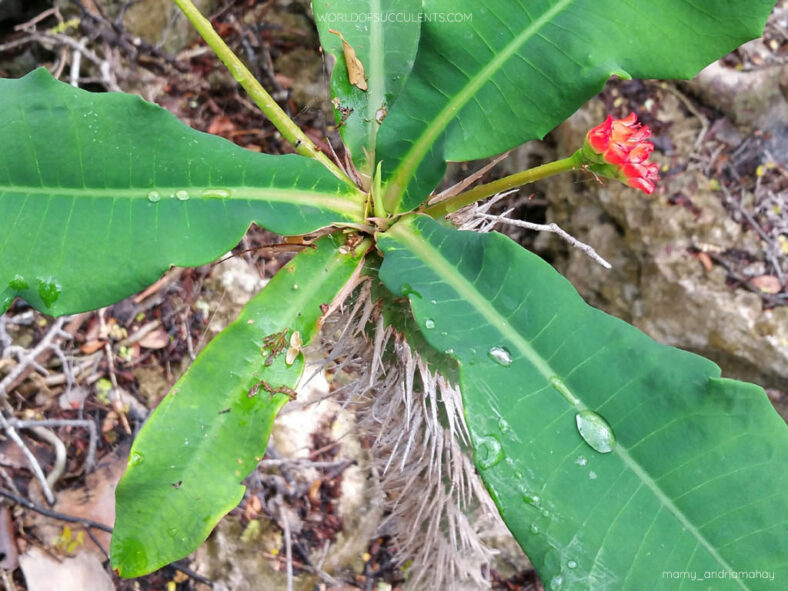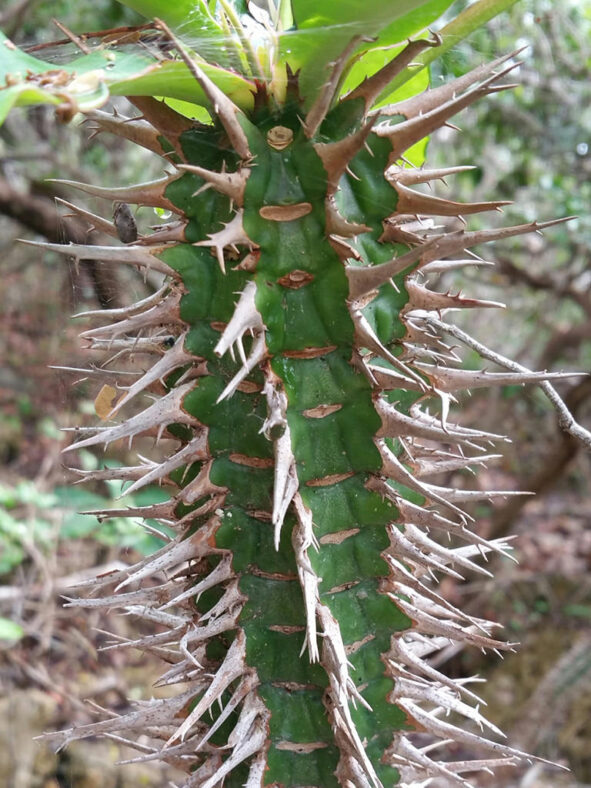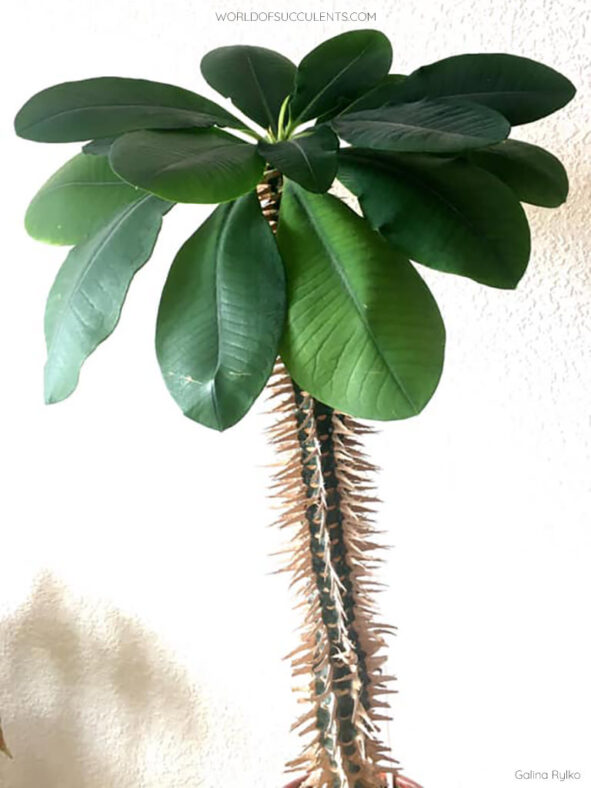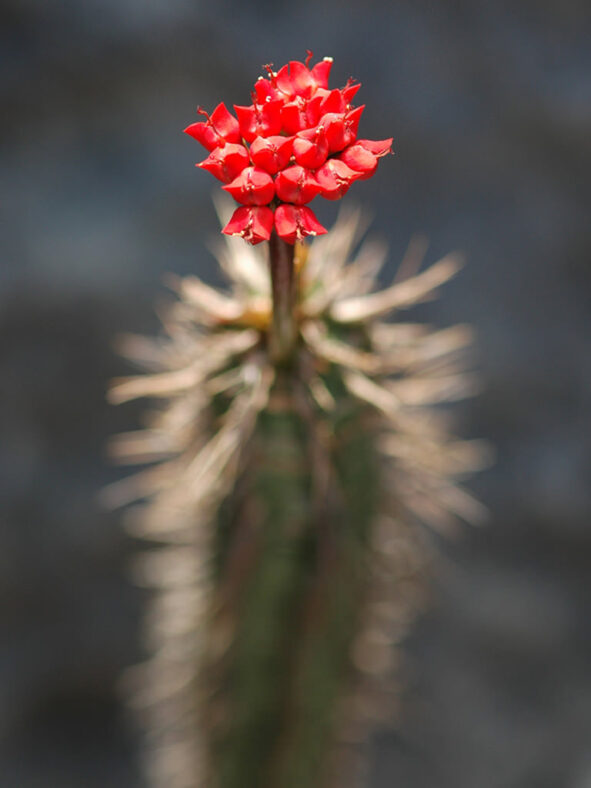Euphorbia viguieri is an ornamental plant that originates from Madagascar. It is a variable species with five recognized varieties.
Scientific Name
Euphorbia viguieri Denis
Scientific Classification
Family: Euphorbiaceae
Subfamily: Euphorbioideae
Tribe: Euphorbieae
Subtribe: Euphorbiinae
Genus: Euphorbia
Etymology
The specific epithet "viguieri" (pronounced "vig-GWEER-ee") honors René Viguier (1880-1931), a French botanist known for his investigations of plants within the family Araliaceae.
Origin
Euphorbia viguieri is native to Madagascar. It grows in open coastal forests on heavily eroded granite rocks.
Description
Euphorbia viguieri is a cactus-like succulent with an upright, rarely branched stem with 5 to 6 ribs lined with yellowish-brown stipules that develop into irregular spines. The stem can grow up to 6 inches (15 cm) tall and 1.2 inches (3 cm) thick. At its lower part, the stem is thinner and takes on a nearly cylindrical shape. The flattened spines form ridges along the ribs and can reach a length of up to 1 inch (2.5 cm).
The leaves of Euphorbia viguieri are emerald green, with a red base and prominent white veins on the underside. They are elongated, oval-shaped, and pointed at the tip, measuring up to 4 inches (10 cm) in length and 1.2 inches (3 cm) in width. They are clustered near the tip of the stem and attached to the stem by a thick, very short stalk. When the leaves fall, they leave large, horizontal, elliptical scars.
During the spring, Euphorbia viguieri produces upright cyathia with bright red to green cyathophylls. The cyathia appear in clusters at the tip of the stem on a stalk that can measure up to 1.6 inches (4 cm) long, with each cyathium reaching a diameter of 0.1 inch (0.25 cm). The fruits are smooth, three-chambered capsules containing one seed in each locule.
Varieties of Euphorbia viguieri
- Euphorbia viguieri var. ankarafantsiensis: This variety is found in the Ankarafantsika forest, located south of Mahajanga. It features oblong leaves with a pointed tip, stalkless inflorescences, and hermaphroditic cyathia with yellow-green cyathophylls with red margins.
- Euphorbia viguieri var. capuroniana: Distributed near Ankara de Diégo, this variety has longer, stronger spines measuring 0.8 to 1 inch (2 to 2.5 cm) in length. It has very short-stalked inflorescences, hermaphroditic cyathia with yellowish-green cyathophylls with reddish-orange margins.
- Euphorbia viguieri var. tsimbazazae: Although its specific distribution is unknown, it may be found near Morondava. This variety features long-stalked inflorescences and leaves with petioles measuring up to 4 inches (10 cm) long. Its hermaphroditic cyathia are bright red, and the cyathophylls are fused.
- Euphorbia viguieri var. viguieri: Besides its type locality near Maevatanana, this variety can also be found in the Montagne des Français Reserve and around Windsor Castle. It has spines up to 0.8 inches (2 cm) long and unisexual cyathia with bright red cyathophylls.
- Euphorbia viguieri var. vilanandrensis: This variety is distributed on the limestone cliffs of the tsingy of Namoroka, near the village of Vilanandrano. It features elliptical leaves that can reach 7.2 inches (18 cm) in length, and stipular spines that fall off quickly. The hermaphroditic cyathia have green cyathophylls.

How to Grow and Care for Euphorbia viguieri
Light: Euphorbia viguieri requires plenty of sunlight for optimal growth. During the warmer months, place it near a sunny window or move it to your balcony or garden, gradually increasing sun exposure to avoid sunburn.
Soil: Use a well-draining soil, either a commercial potting mix formulated for succulents or create your own well-draining soil.
Temperature: While high summer temperatures are not a problem, low winter temperatures can damage or kill your plant. Euphorbia viguieri grows best in USDA Plant Hardiness Zones 10a to 11b, with average minimum winter temperatures ranging from 30°F to 50°F (-1.1°C to 10°C).
Watering: From spring to fall, water the plant when the top inch (2.5 cm) of the soil feels dry. Reduce watering in winter and give it just enough water to prevent wilting. During the warm season, the evening is the best time of day for watering.
Fertilizing: To ensure the potted plant receives sufficient nutrients, apply a balanced fertilizer in a 10-10-10 NPK formulation, diluted to 1/4 strength weekly during the growing season.
Repotting: Although your Euphorbia viguieri does not need to be repotted often, it will benefit from repotting when it outgrows its pot. Repotting is best done in early spring, at the beginning of the growing season. When handling this plant, wear gloves, protective clothing, and appropriate eye protection.
Propagation: The easiest and fastest method to propagate this plant is by stem cuttings. While starting Euphorbia viguieri from seeds is possible, germination can be challenging. Take cuttings only during the growing season. Spring is the ideal time to sow the seeds.
Learn more at How to Grow and Care for Euphorbia.
Toxicity of Euphorbia viguieri
Euphorbia viguieri produces a poisonous white milky sap that may cause burns or irritation if it comes into contact with the skin or eyes. Therefore, it is best to keep this plant out of the reach of children and pets.
Links
- Back to genus Euphorbia
- Succupedia: Browse succulents by Scientific Name, Common Name, Genus, Family, USDA Hardiness Zone, Origin, or cacti by Genus
Photo Gallery
Click on a photo to see a larger version.


